
If human beings were
intended to fly, The Intelligent Designer would
have made their poop white.
-- Paul
Niquette
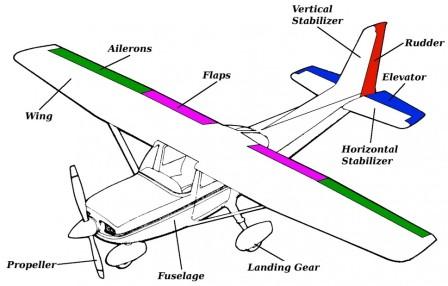
Diagram obtained under Fair-Use
from StartFlyingRC.
AGL
(Altitude) Above Ground Level, where all aircraft
must fly. Always a positive number, by the way.
Distinguished from MSL, (above)
Mean Sea Level, which is what an altimeter measures,
and can indeed be negative. Cloud levels are given
as AGL.
When in doubt, hold your
altitude. No one has ever collided with the
sky.
-- Old
Aviation Saying
| In 1980, a friend of mine
set one of aviation's lesser known world
records: Low-Altitude Endurance, flying at
-200 feet MSL (+50 feet AGL) for over five
hours, in Death Valley (now her husband
plans to set the high-altitude submarine
record with a one-man submersible in Peru's
Lake Titicaca).
To determine altitude AGL
-- the most vital measurement aloft -- the
pilot must know: (a) the plane's altitude
MSL, (b) the plane's geographical
position, and (c) the elevation (MSL) of the ground (the
G in AGL) at that location.
|
aileron Movable
surface on the outboard trailing edge of each wing.
Operated by rotating the control wheel (or tilting
the stick from side to side), the ailerons control roll (animation).
Aileron is one of the few pure
aviation terms and was derived from the diminutive
form of the French aile (wing). Other French
contributions: empennage,
fuselage, and longeron.
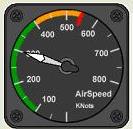 airspeed
The speed at which the airplane moves through the air
expressed in knots
(kts nautical miles per hour). airspeed
The speed at which the airplane moves through the air
expressed in knots
(kts nautical miles per hour).
Airspeed is distinguished from groundspeed and comes in
two forms: 'Indicated airspeed' (IAS),
corrected for altitude and temperature, becomes
'true airspeed' (TAS). Thus "truing
out" at 150 KTAS with
a 15-knot tailwind "makes good" 165 knots "over the
ground."
| In early days of aviation,
airspeeds were expressed in mph (statute
miles per hour) same as
automobiles and trains. Marketing
psychology doubtless played a role: To say
your sedan goes "100 mph" is more exciting
than "87 kts" -- much as $100 is preferred
for a prize, while $99.95 works better as a
price.
Back in 1937, for one
flight of 2,228 nm (2,566 sm),
confusion about kts and mph for winds aloft
may have participated in tragedy (see Which
Way, Amelia?).
|
Airspeed, altitude and
brains: any two out of the three are needed to
complete the flight successfully.
-- Old Aviation Saying
alphabet, phonetic
Alpha, Bravo, Charlie (shar-lee), Delta,
Echo, Foxtrot (often shortened to Fox), Golf, Hotel,
India, Juliet, Kilo, Lima (pronounced as the city not
the bean), Mike, November, Oscar (oss-kah), Papa,
Quebec (kay-beck), Romeo, Sierra, Tango, Uniform
(oo-nee-form), Victor (vik-tah), Whiskey, X-ray,
Yankee, Zulu.
Use these in casual conversation
anywhere in the world and pilots will reveal
themselves by asking, "What are you flying?"
Never drop the airplane to fly
the microphone.
altimeter An instrument
that measures air pressure, like a barometer.
See MSL.
The face is calibrated in
'feet MSL' and an adjustment ("Kollsman Window")
that enables correcting for local atmospheric
pressure, which is in turn given as 'inches of
mercury' (29.92 being the so-call "Standard
Atmosphere"). Clear?
Radar altimeters measure altitude
above ground level AGL
directly but are extremely rare in light aircraft;
they will doubtless become more common with the
growth of the VLJ fleet.
altitude
Three entries: Above
Ground Level , Above
Mean Sea Level, Density Altitude.
angle-of-attack
The angle between the chord of the wing and the
relative wind (also called angle-of-incidence).
| The chord is simply the
straight line that connects the leading edge
of the wing with the trailing edge (longest
dimension front-to-back). The relative wind,
not so simply, is the direction from which
the air appears to be coming. In level
flight, the relative wind strikes the plane
horizontally from straight ahead. During
ascent (or descent), the relative wind comes
from above (or below) the plane. |
AOPA Aircraft Owners and Pilots
Association, non-profit political organization
serving the interests of its members to promote
the economy, safety, utility, and popularity of
flight in general
aviation aircraft.
Area Rule An ironic
aerodynamic property for minimizing drag
in high-speed aircraft.
| Discovered back to the
fifties, the rule mandates a constant
crossectional area as measured at stations
along the center-line of the aircraft.
Thus the fuselage on some aircraft
accommodates the wings by virtue of
"coke-bottle" design.
As the VLJ
segment of General
Aviation fleet becomes prominent,
private pilots can expect increased
pertinence for jet-age lingo, like "thrust
lever," "engine pressure ratio," "turbine
stall," "flame-out," and "after-burner"
("reheat" in UK parlance).
|
 Artificial
Horizon or
Attitude Indicator, an instrument symbolizing the
aircraft in the center, and the background
controlled by a gyro. Artificial
Horizon or
Attitude Indicator, an instrument symbolizing the
aircraft in the center, and the background
controlled by a gyro.
Depicted
on the right is an artificial horizon in the panel
of an aircraft that is momentarily pitching up 5 degrees and rolling right by 15 degrees.
ATC Air
Traffic Control, a service of the FAA (Federal
Aviation Administration) in which air traffic
controllers are responsible to guide and protect
airplanes (see traffic).
| Most people are familiar
with control towers. The 'tower' operators
(also called 'local' controllers) are
responsible for planes in the process of
landing and taking off. 'Ground control'
directs planes on the ground. Movie-makers
take note: you never call ground control
while in the air. At the radar scopes you
have 'departure' controllers, 'enroute'
controllers, and 'approach' controllers.
The vast majority of
airports do not have control towers. Most
use Unicom or CTAF
(Common Traffic Advisory Frequency) to
exchange information among the pilots
flying in the pattern. Works fine, by the
way. ("Caldwell traffic, Cardinal Niner
One Four, wing-up, turning right base for Runway
Three Zero, behind the Cherokee.")
|
ATIS Automatic
Terminal Information Service (pronounced ATE-is), a
transcribed radio message that gives up-to-date
advisories about conditions and procedures at a
particular airport. The pilot listens to the message
on the ground before taxiing and in the air before
approaching the airport.
| "Torrance Airport,
Information Juliet, zero-two-zero-zero Zulu.
Weather: sky partially obscured, two
thousand scattered, two-five thousand
broken. Visibility: five, haze. Wind:
two-seven-zero at one-five. ILS Two-Niner
Right approach in use, landing and
departure: Runways Two-Niner Right and
Two-Niner Left. Caution equipment in use on
taxiway kilo. Advise on initial contact, you
have received Information Juliet." |
attitudes,
unusual In aviation, the expression
'unusual attitudes' has a special meaning. Just so
you know, it has nothing to do with extraordinary
mental states or peculiar dispositions. 'Attitude'
is the general term used to describe (ahem) the
instantaneous angular position of the airplane with
respect to the horizon.
| Attitude is a vital thing
for the pilot to know -- which way is up? --
and to control. The task is made easy when
you can see the horizon out the window,
difficult -- hard! -- when you cannot.
Straight and level flight is one of the most
common -- 'usual' -- attitudes, as are
climbing, descending, and coordinated
turns.
So then, what is an
'unusual' attitude? It is any attitude not
required for the normal conduct of flight.
Unintentional attitude is more to
the point.
Airplanes tend to
'over-bank' constantly. Here's why. Say a
slight disturbance lifts the right wing.
Suppose that, through momentary pilot
inattention, it is not immediately
corrected. A left turn ensues. That might
not be especially inconvenient -- if you
happen to desire a left turn. Inadvertent,
though, and you have an unusual attitude.
Over-banking results from
the turn itself. Intended or not, while
flying in a curving path the outside wing
has farther to go than the inside wing.
For the case under consideration, that
means the right wing is traveling faster
than the left wing, and develops more lift
-- rolling your plane more steeply to the
left. The motion can be exceedingly
subtle. You are not likely to feel it.
Most likely, though, the
pilot is the problem. Carelessness in
cross-checking the instruments and errors
of interpretation, confusion and
disorientation, lack of training or being
out of practice -- these are among the
foibles that beset the person at the
controls.
Unusual attitudes are not
really so unusual. Safety dictates that
you must learn how to recover from them,
which often requires dealing with vertigo.
|
Mankind has a perfect record in aviation; We
never left one up there yet.
-- Old
Aviation Saying
autopilot Airborne
electronic equipment that automatically actuate the
controls of an airplane.
The simplest is called a 'wing
leveler,' which is capable merely of 'roll-hold.' You might add 'heading-hold,' 'pitch-hold,' and
'altitude-hold.' Finally, there is the
'coupler', which connects the autopilot to your navigation system. Then you
might ask yourself why you ever took up flying.
avigation an aviation neologism (see navigation).
The
sky, to an even greater extent than the sea, is
terribly unforgiving of errors.
--
Old Aviation Saying
AvWeb Web-based,
independent aviation news resource.
azimuth Angle
measured between some reference line, generally north (either magnetic or true)
and a fix or a target (in radar). If the
reference line is the longitudinal axis of the
aircraft, the preferred term is bearing.
bank Same as roll. 'Angle-of-bank' is that
which the wings momentarily make with the horizon.
In 'coordinated turns' (neither slipping nor skidding),
best to think of your fanny as 'down' and what you
see through the plexiglass as a crooked picture on
the wall.
balance See weight-and-balance.
base leg
See pattern.
beacon Coded signal,
either a rotating light (atop an obstacle or an
airport tower) or a navigational radio (most often
called an NDB for
"non-directional beacon").
At a civilian airport the
light signal alternates between green and white; for
military aerodromes, the beacon appears to flash
green-white-white.
Radio beacons are suitable for direct
inbound navigation (homing)
or for taking cross-bearings;
they are subject to errors in outbound navigation
(see ADF).
bearing An angle measured clockwise relative
to some reference, often the longitudinal axis of
the airplane (see numbers)
or from North (see omni).
Best Angle of Climb Indicated airspeed
(abbreviated "V X" in V-speeds)
that enables the aircraft to ascend in altitude at
the steepest angle (minimum distance), most
relevant for clearing obstacles, distinguished
from -- and slower than -- Best
Rate of Climb speed.
Best Rate of Climb Indicated airspeed
(abbreviated "V Y" in V-speeds)
that enables the aircraft to ascend in altitude at
the fastest rate (minimum time), most relevant for
minimizing time enroute, distinguished from -- and
faster than -- Best Angle
of Climb speed.
blip The spot on the
radar screen corresponding to the echo of an
airplane, also called 'target' (see transponder). Maybe blip
sounds like what a spot looks like.
CAP Civil Air Patrol,
a civilian auxiliary of the United
States
Airforce.
CAVU Ceiling And
Visibility Unlimited, colloquially 'severe clear.'
The extreme opposite of WOXOF, "indefinite ceiling
zero, sky obscured, visibility zero with fog"
(decoded from old fashioned weather teletypes).
ceiling A broken or
overcast cloud layer at some measured elevation AGL.
For landing an aircraft, the pilot
must have some prescribed forward visibility, often
a mile, under a ceiling of at least a few hundred
feet. These are the so-called 'landing minimums',
and they vary from airport to airport.
celestial navigation
Nautical procedure appropriated by commercial and
military aviation in bygone days for finding position
based on angular measurements of sun, moon, and stars
(more at sextant).
checklist
An ordered set of references to procedures vital to
the safe conduct of flight. Checklists are
customarily printed on laminated pages bound into a
notebook immediately accessible to the pilot in
command.
| A given checklist pertains
to a specific phase of flight:
Pre-Flight Inspection,
Before-Starting-Engine, Pre-Taxi,
Pre-Take-Off, Approach-to-Landing,..
Emergencies (by type).
Every item on a checklist
has two parts, the first in the form of a
noun phrase called the “challenge,” for
each of which a “response” is
mandated: "Flaps -- Set"; “Landing
Gear – Down and Locked, Three-Greens
Showing”; "Mixture -- Full
Rich."
A checklist does not tell
the pilot how to perform the
procedure. Technical manuals and
flight training are supposed to do that.
Aviation mnemonics are
commonly used as informal checklists
(CIGAR, GUMP, CCCC, TTTTT), with varying
degrees of effectiveness.
|
A checklist is not a
do-list.
– Old
Aviation Saying
chronometer A precise
time piece used in navigation.

Illustrated above is an
especially fancy one, perched for the night atop an
E6B computer. You see
plenty of bezels and buttons plus an auxiliary
movement for GMT. Given
the indicated settings, the pilot must be slumbering
in which time zone?
| Time waits for no one.
Whoever first sang
those words might have been thinking of
aviation, where passing the middle marker on
the ILS requires reading
the chronometer immediately in order to
declare a 'missed approach' when the time
comes.
Nota bene, celestial
navigation experiences a full mile
of shift in longitude at the equator with
every 3.5 seconds of error in time
measurement.
|
CIGAR An abbreviated
pre-take-off checklist: Controls (free and correct),
Instruments (heading, altimeter, horizon), Gas (fuel
selector on fullest tank), Attitude (trim),
Run-up (testing of the engine prior to take-off).
| The least useful acronyms
are those which provide no mnemonic support
for sequence: TTTTT (Time, Turn,
Throttle, Tune, Talk) for the five things
you are supposed to do at the outer marker
(which I have replaced with "watchman power
and radio chatter"); for emergencies, I
replaced the traditional CCCC
(Climb, Confess, Communicate, Comply) with
my on credo: PADO (Pull-up, Admit that I
need help, Describe my predicament, Obey
instructions). |
Aviate, Avigate,
Communicate -- in that order.
-- Not so old aviation saying.
clearance Loosely
speaking, an agreement between ATC
and the pilot of an aircraft, under the terms of which
safe separation from other aircraft is assured in the
event of communications failure. Simple clearances
include permission to taxi somewhere on the airport,
to take off, to land, to change frequencies.
| Under IFR,
a clearance covers a chain of in-flight
procedures, which must be taken down by the
pilot in "aviation shorthand" from clearance delivery and
read back verbatim. Here is an
example: C34914 CLRD TO SFO M3 EXP H IN
5MIN. MRH TO X SLB R123, RT 270, RV TO
LAX VOR. FPR. DEP 126.4,
SQ3241. Which sounds like this over
the radio…
"ATC Clears Cardinal Three
Four Niner One Four to the Santa Francisco
Airport. Maintain three thousand. Expect
higher five minutes after departure.
Maintain runway heading until crossing the
Seal Beach one-two-three degree radial,
right turn heading two-seven-zero for
radar vectors to Los Angeles VOR. Flight
plan route. Contact Departure Control,
126.4. Squawk 3241. Proceed with your
readback."
|
cockpit Where you
control a plane from, which everybody knows. With
the increasing presence of women in flight crews,
the term is being displaced by 'flight deck.'
As with other terms ('navigate,' 'dead
reckoning,' 'rudder'),
'cockpit' came to aviation by way of maritime
parlance, there being a lower space near the stern
from whence some vessels are steered. Just so there
is no misunderstanding, 'cock' derives originally
from the fighting bird.
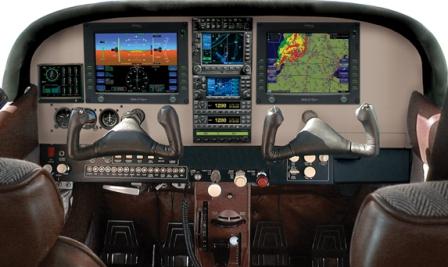
cockpit, glass Collection of flat-screen,
twenty-first century displays. Prepare to learn a
whole new collection of TLDs,
including FMS, SVS,
and PFD.
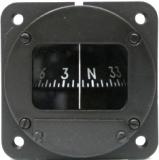 compass
A
primitive instrument that indicates magnetic
heading. It has digits painted around a black
cylinder that floats in a bath of mineral oil.
The thing is subject to many kinds of errors as the
plane maneuvers -- so much so, that a pilot must
rely instead on his or her "heading indicator,"
which is stabilized by a gyro. compass
A
primitive instrument that indicates magnetic
heading. It has digits painted around a black
cylinder that floats in a bath of mineral oil.
The thing is subject to many kinds of errors as the
plane maneuvers -- so much so, that a pilot must
rely instead on his or her "heading indicator,"
which is stabilized by a gyro.
Both instruments are subject
to the same design flaw. The designer was
obviously ignorant of human factors and suffered a
misguided penchant for abbrev.
| For safety's sake,
headings are invariably given over the
radio as three digits. That's called
'redundancy.'
Thus,
North-West is said,
"three-zero-zero." On both compass
and heading indicator, the least
significant digit is deleted on
every printed number, such that North West
reads "30." That's bad enough,
but then leading zeroes are also
deleted (must be to save paint).
That means North-East, which is said
"zero-three-zero," reads just plain
"3." Now, 30 is exactly 270 degrees
from 300, making the expression "right
angle" a potentially fatal -- well, misnomer.
And yes, a high-time pilot I know
personally has experienced the indicated
inadvertence while aloft in IMC. |
course Intended
direction of flight -- usually referenced to magnetic
North, some place up in Canada where compasses point.
Because of wind, your course generally differs from
your heading.
crab Angle between course and heading
resulting from the influence of a crosswind
component.
Crab is especially onerous on landing.
The pilot uses an intentional (side) slip to correct it out; otherwise
the wheels will not be lined up with the runway at
the instant of touchdown.
crosswind landing,
crosswind takeoff Runways are generally
designed to be lined up with the wind. Once the
airport is built, though, it doesn't always work out
that way.
| If a significant component
of the wind is blowing across the runway,
an airplane taking off tends to skid
sideways just as the wheels leave the
ground. For a crosswind take-off,
the pilot anticipates this tendency by
prepositioning the aileron
control for a turn into the wind before
releasing the brakes. Immediately
after take-off the plane actually does
turn into the wind and then commences to crab along the runway.
Best to explain these matters to your
passengers before starting the engine(s).
Crosswind landings have
the same problem in reverse, but not
the same solution. The preferred
approach is to execute an intentional slip by banking into
the wind and holding opposite rudder to cancel
out the effect of the crosswind and to
keep the plane's landing gear lined up
with the runway. Of course, with
the plane banked, one wheel will
touch-down first, but -- hey, nobody
ever said crosswind landings have to be
pretty.
|
Flying is the second-most
thrilling experience in life; the first is
landing.
crosswind leg
See pattern.
cruise-climb Conventional
maneuver in the early stages of each flight, using
the indicated airspeed
recommended in the owner's manual for the
aircraft, calling for a pitch angle that affords
good forward visibility and an air-flow that assures
good engine cooling, distinguished from -- and
faster than -- Best Angle of
Climb speed and Best
Rate of Climb speed. The abbreviation "V CC"
in the V-Speeds is a
coinage for this glossary.
CUT Coordinated
Universal Time (see GMT.).
curve, power See drag.
dead reckoning
An unclever contraction of 'deductive reckoning,'
which uses speed and direction together with elapsed
time to estimate one's present whereabouts from some
previously known position. In aviation, the
procedure is especially prone to errors, primarily
because of winds, but it's anything but
"dead."
The preferred term is pilotage. Likewise, the
phrase 'positioning flight' seems to have replaced
'dead-head' in aviation parlance.
| There is some controversy
about the derivation of the phrase.
According to the Oxford English
Dictionary, the 'dead reckoning'
dates from Elizabethan times
(1605-1615). The popular etymology
cited here is not documented in
any historical dictionary. Instead,
'dead reckoning' is navigation without
celestial references. Whereas with stellar
observation, you are, in some sense, live
-- working with the stars and the movement
of the planets. Conversely, using
mere compasses and clocks but no sky, you
are working dead. |
delivery,
clearance A position in the control
tower responsible to obtain the authorized
procedures for each flight under IFR
and to provide them as an official clearance to the pilot over
a dedicated radio frequency.
density altitude
An aviation expression used to
describe the effects three factors that determine
the local density of the air.
The three H's are invoked as a
mnemonic: HHH for High,
Hot, and Humid. That adds up to
'high density-altitude' -- a perilously poor
term. It really means 'low-density air.'
Engines gasp, propellers flail inefficiently,
and wings find scant support. To stay aloft in
this rarefied stuff, you must fly over the
ground faster than normal, though your airspeed
indicator, which is thrown out of calibration,
reads the same. For an anecdote, see Maritime Air.
|
DF Direction Finding, generally
referring to a primitive radio receiver and
instrument on the ground at an airport control
tower or a Flight
Service Station (FSS).
The
use of DF for assisting a lost pilot requires two-way
radio communications ("Which way,
Amelia?"). Typically, the operator on
the ground will say over the radio, "Give me a
short count, please." The pilot responds,
"1-2-3-4-5-4-3-2-1, over." The DF needle indicates
azimuth to the aircraft
which can be transmitted by voice to the pilot (as
soon as he or she remembers to release the
microphone key).
You are
invited to admire a world-class collection of
radio direction finders here.
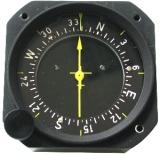 ADF, Automatic Direction Finding is
an onboard receiving instrument, with a needle
that continuously indicates bearing
to a selected radio beacon
on the ground or commercial broadcast
station. The instrument on the right has
been manually set using the knob so that the
aircraft's heading, 340 degrees, appears under the
lubber; meanwhile, the
needle, which automatically points to the tuned-in
radio station or beacon, is
indicating that the aircraft is indeed homing on that heading with
no apparent crosswind. ADF, Automatic Direction Finding is
an onboard receiving instrument, with a needle
that continuously indicates bearing
to a selected radio beacon
on the ground or commercial broadcast
station. The instrument on the right has
been manually set using the knob so that the
aircraft's heading, 340 degrees, appears under the
lubber; meanwhile, the
needle, which automatically points to the tuned-in
radio station or beacon, is
indicating that the aircraft is indeed homing on that heading with
no apparent crosswind.
| ADF
dates back to olden times, long before the
VOR became a reality in
aviation. Which explains what you hear
even today in radio broadcasts, "We pause
now for station identification [just in
case there's some lost soul in the sky
who's trying to use his or her ADF to
figure out where the hell he or she
is]."
Personal
Note The ADF on the panel in Two-Four Fox was
routinely kept tuned to KNX
1070 AM, a 50,000-watt 'clear channel'
broadcast station located near Torrance
Airport. The needle always pointed
home on flights
all over the West, even from as far away
as the tip of Baja
California.
|
DME Distance
Measuring Equipment, an instrument that determines
distance of the aircraft from a selectable
navigation aid on the ground.
The DME in the aircraft acts
like a transponder, only
in reverse, sending out a pulse of radio energy in
all directions and measuring the time interval for
the return signal at the speed of light from the DME
on the ground.
The facility on the ground is usually
co-located with a VOR and is
operated under a "frequency pairing
plan." The combination is called VORTAC, an acronymic
portmanteau, which combines VOR
with TAC, which is an abbreviated TLD
for TACAN, which stands for Tactical Air Command Air
Navigation. Clear?
DOF Degrees of
Freedom, of which every solid object enjoys six.
Here are their names in aviation parlance alongside
their corresponding (nautical terms in parentheses).
- Moving up and down
~~~~~~~~~~~~~~~ climbing/diving (heaving)
- Moving left and right
~~~~~~~~~~~~~~~ slipping/skidding
(swaying)
- Moving forward and backward
~~~~~ accelerating/decelerating (surging)
- Tilting forward and backward
~~~~~~~~~~~~~~~ pitching (pitching)
- Turning left and right
~~~~~~~~~~~~~~~~~~~~ yawing (yawing)
- Tilting side to side
~~~~~~~~~~~~~~~~~~~~~~ rolling (rolling).
drag Force acting to
retard the motion of the plane or to keep people
from having fun at a party.
 All
things that move through fluids experience drag.
Airplanes are distinguished by the fact that for them,
there are two kinds of drag. Common old ordinary drag
is called 'parasite' drag, which becomes greater with
increasing speed, the same as for barracuda and boats,
bikes and blimps, bullets and buses. Airplanes
also experience a pernicious form of drag, which
paradoxically increases at low airspeeds. It is called
'induced' drag -- induced by the act of flying. All
things that move through fluids experience drag.
Airplanes are distinguished by the fact that for them,
there are two kinds of drag. Common old ordinary drag
is called 'parasite' drag, which becomes greater with
increasing speed, the same as for barracuda and boats,
bikes and blimps, bullets and buses. Airplanes
also experience a pernicious form of drag, which
paradoxically increases at low airspeeds. It is called
'induced' drag -- induced by the act of flying.
Added together and graphed against
airspeed, these two drags form a U-shaped curve.
Corresponding to the bottom of the curve is the
'minimum drag speed,' usually about 30% above the
airplane's stall speed. In
still air, this is the most efficient airspeed,
giving the greatest distance for the least fuel
consumption.
By the way, since drag is overcome by
thrust (or 'power'), an airplane exhibits a U-shaped
'power curve.' Hence the expression that has been so
rudely appropriated by management and politicians,
"getting behind the power curve." It means flying so
slow that no amount of power can prevent a stall.
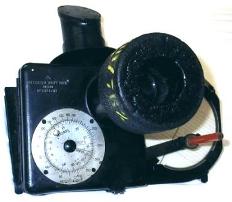 drift meter Telescopic
instrument (obsolete) used in dead
reckoning, that enabled an aircraft navigator to
peer down through the aircraft's fuselage
and measure the lateral motion of objects on the
ground thereby enabling adjustments of the aircraft's
heading to correct for
crosswind. drift meter Telescopic
instrument (obsolete) used in dead
reckoning, that enabled an aircraft navigator to
peer down through the aircraft's fuselage
and measure the lateral motion of objects on the
ground thereby enabling adjustments of the aircraft's
heading to correct for
crosswind.
One obvious limitation:
clouds that obscure the ground. For flying
over open water, whitecaps can be tracked; however,
for that, a wind at the surface must be greater than
about 10 knots (see Which way,
Amelia?)
DUAT FAA's Direct User
Access Terminal, a free service for qualified pilots,
providing self-service weather briefing, flight
planning and filing.
 E6B
Computer A circular slide-rule used to perform
in-flight calculations, such as time-distance-speed,
fuel consumption, and wind-triangle. E6B
Computer A circular slide-rule used to perform
in-flight calculations, such as time-distance-speed,
fuel consumption, and wind-triangle.
Doesn't have batteries.
That's neat. Not only that but, unlike GPS, the E6B is not disabled by
solar flares in the daytime.
elevator
The movable surface at the trailing edge of the
stabilizer (the horizontal part of the empennage).
Operated by pulling or pushing the control wheel (or
stick), the elevator controls pitch
(animation).
Many
planes have a single, movable surface ('stabilator').
| 'Elevator' is a misleading
term. Within limits, the throttle controls
'elevation.' The elevator -- through pitch
-- controls airspeed.
While it is true that
pulling back on the control wheel, which
pushes down on the tail, imparts an upward
motion to the plane, the long-term effect
is to slow your airspeed. Enough of that
and you achieve a stall.
Old saying: "To go up, pull back. To go
down, pull all the way back."
|
ELT Emergency Locator
Transmitter, a radio beacon mounted in the aircraft
usually near the tail, activated by an accelerometer
in the event of a crash. The signal is picked
up by low-earth orbiting satellites for use in search
and
rescue operations.
empennage The tail assembly of an airplane,
including rudder and elevator.
Empennage is one of the few pure
aviation terms and was derived from the French word
(tail feathers of an arrow). Other French
contributions: aileron, fuselage, and longeron.
engine, critical
The most important flight parameter in multi-engine
flying is Vmc, which represents the expression
"minimum controllable airspeed with the most critical
engine out."
The most critical engine for
a twin is the one on the left wing, which is
determined by the P-factor.
For a single-engine aircraft, the most critical
engine is... never
mind.
engine, General
Aviation The most
common powerplant for light aircraft may be
described as [deep breath here]...
...internal
combustion engine, gasoline-powered,
spark-ignition, with four-stroke
reciprocating-pistons, dual-magnetos,
normally-aspirated carburetor or servo-managed
fuel injection, with or without turbocharging,
configured with either four or six
horizontally-opposed cylinders, displacing 100 to
400 cubic inches of swept volume, air cooled or
(rarely) liquid cooled, with inlets and exhausts
managed by overhead poppet valves engaged by
spring-return rocker arms activated by externally
sleaved push-rods riding on gear-driven cams in
the crank case, producing 100 to 300
brake-horsepower at sea-level, either directly
driving or via reduction gear to spin a metal
propeller with two- or three-blades, delivering
thrust by fixed-pitch or by pilot-selectable,
governor-controlled, constant-speed between 1,500
and 2,800 RPM.
The
two most prominent manufacturers are Teledyne
Continental
Motors and Textron
Lycoming, with BRP Rotax
taking a strong position in the LSA
market.
You can tell
quite a lot about an airplane's powerplant by
its model number, for example the Continental GTSIO-520C
features...
Geared
propeller, Turbo-Supercharged,
direct fuel Injection,
horizontally Opposed, 520Cubic
Inches; for number of cylinders, you have to
know that, for the same displacement,
Continental favors six and Lycoming four.
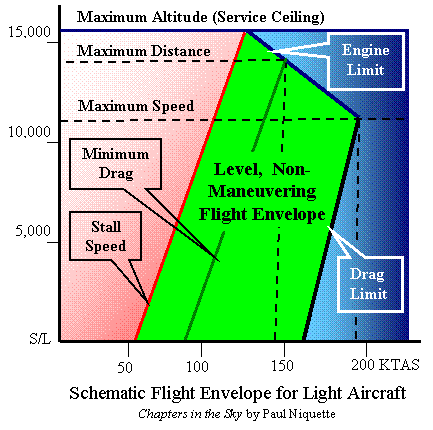
envelope, flight A representation of
limits that characterize the performance of an
aircraft in varions operating modes, as exemplified
for a light aircraft in level, non-maneuvering flight
in the diagram on the right. Observe...
- Stall Speed sets the
lower boundary on airspeed at all altitudes
dominated by induced drag and
is seen to increase with altitude: This edge of
the envelope mandates that one must move faster
through the air the higher one flies to keep the
plane from stalling.
- Drag Limit sets the upper
boundary on airspeed at lower altitudes dominated
by parasite drag and is seen
to increase with altitude, as the rarified air
reduces its resistance to flight, allowing the
plane to fly higher and faster until the...
- Engine Limit sets the
upper boundary on airspeed at higher altitudes
dominated by the volumetric efficiency of the
engine in developing power for thrust,
decreasing with altitude and thus slowing the
plane until reaching...
- Maximum Altitude (Service
Ceiling) at which the Engine Limit
boundary intersects the Stall Speed
boundary at the top of the...
- Level, Non-Maneuvering Flight
Envelope, such that an aircraft flying
anywhere within the green
area can fly at a constant altitude
with extra power available for climbing to a
higher altitude, increasing airspeed, maneuvering
in turns, and overcoming turbulence.
- Maximum Speed for level
flight is seen to be defined at the intersection
of the Engine Limit and the Drag Limit.
- Minimum Drag is
characterized by induced drag and parasite drag
being approximately equal, which occurs typically
at 1.3 times stall speed, and is seen to determine
the
- Maximum Distance the
flight can achieve in the absence of headwind.
Unlike weight-and-balance,
which imposes boundaries that must never be crossed,
flight outside the envelope depicted here may be
safely accomplished by maneuvers from inside the green area. Zooming, for example, is a
transient maneuver which trades airspeed for
altitude. Within redline
limits, diving trades altitude for airspeed and can
be sustained so long as there is plenty of altitude
AGL to spare. See "pushing the envelope."
ETA Estimated Time of
Arrival at a fix or destination (preferably GMT). Distinguished from ATA, Actual Time of
Arrival.
ETE Estimated Time
Enroute to next fix (usually in minutes) or to
destination (hours and minutes), critical for
estimating fuel requirements. Distinguished from ATE, Actual Time
Enroute.
FAA Federal Aviation
Administration, U.S. Government institution
responsible for regulating
all aspects of aviation.
FADEC Full Authority
Digital Engine Control.
Just the thing for 21st
century flying, especially in light aircraft with
diesel engines that burn jet fuel. FADECs
monitor and simplify engine operation (throttle,
propeller, mixture), enable single lever power
control, support improved engine starting , reduce
fuel consumption through parameter optimization, and
perform real-time data logging.
fail-safe Does not mean
the same as fail-proof. Everything made
by man fails (same for all other things, come to think
of it).
| A fail-safe system
incorporates redundancy ('back-up'), so that
an isolated failure
(‘single-point-of-failure’) shall not result
in catastrophe. Moreover, a
single-point-of-failure must not go
undetected (‘unrevealed’ is my term for
it). That would obviate
redundancy.
The popular juxtaposition
‘safety-and-reliability’ has meaning only
by virtue of systematic measures that
assure the joint unlikelihood of simultaneous
multiple failures.
Piston engines have dual
ignition systems, both independent of the
plane's electrical system, with two spark
plugs in each cylinder energized by
separate magnetos that are individually
tested before take-off. Planes also
have two wings; however,...never mind.
|
FARs Federal Aviation
Regulations ("regs").
FBO
Fixed Base Operator, an airport concessionaire
(sometimes also the airport owner) who offers vital
services, including fuel, repair, and ground
transportation.
Some FBOs run charter services and
sell or rent airplanes. The etymology of FBO is
unknown to this author. I like to suppose that it
was originally a term of distinction: the early
'barnstormers,' always on the move, would not have
qualified for any term with 'fixed' in it. {Egg
Plant
on Wheels}
FBW Fly-By-Wire, flight
controlled from the cockpit by
electronic signals in place of direct mechanical
connections to stick and rudder pedals via cables and
hydraulic lines, augmented by computer
processing of sensor information to fulfill
pilot commands efficiently and safely.
FIKI Flight into
known icing. Not recommended -- forbidden,
actually -- except for aircraft equipped with
de-icing features and a pilot who knows how to use
them.
final,
(final approach)
See pattern.
fix Location in space
at a particular time reckoned by the pilot or
determined automatically (see GPS,
LORAN) during flight.
The term 'position' (the P
in GPS) is most frequently used to describe a
flight's location with respect to a feature on the
ground. The word 'waypoint' refers to a
'position' along a planned course.
flap Surface on the
in-board trailing edge of each wing, which when
extended deepens the effective thickness ('camber') of
the wing, changing the relationship between lift and drag.
Strictly speaking, flaps do not
increase lift, which in steady flight equals the
weight of the aircraft. With the flaps extended,
stall speed is lessened, permitting slower flight
for landing. (Cowl flaps are a different thing; they
control the cooling of the engine. Marital flaps are
cockpit discussions resulting from both partners
holding pilots' licenses.)
flare Increasing pitch,
nose up, just prior to landing, a rounding-out
maneuver intended to transition from descent on the
glide path to horizontal motion -- on the runway, of
course...
There are three simple
rules for making a smooth landing.
Unfortunately no one knows what they are.
-- Old Aviation
Saying
| Sitting in the right seat of
a Skylane, I watched with admiration while
the pilot executed a perfect approach in a
stiff but steady wind at Flagstaff, Arizona,
flaring just right so that, with the plane
nearly stopped, the wheels might 'smooch'
the pavement without even squealing --
except for one thing: I could see the shadow
of the right main gear wheel on the runway
four feet below the right main gear
wheel. The pilot peered over the instrument
panel and grinned, preparing to taxi off the
runway and accept my applause. Then all at
once: ka-thunk. Glad I was there. |
flight level (FL)
Assignment by ATC
for IFR altitude separation of
flights above transition
altitude of 18,000 feet MSL,
which is safely higher (AGL) than
highest terrain in the U.S.
FL is given in multiples of 500
feet using standard sea-level atmospheric pressure
of 29.92 inches of mercury. History of the
concept provided by Altitude Telemetry.
flight log A document
created before
take-off and updated by the pilot while aloft to
keep track of information essential for the safe
execution of the flight. Here is an example of a
modern flight planning form,
specifically designed to fit on a knee
board.
| Conventional abbreviations
are abundant, including ALT altitude (MSL), ATA actual time of
arrival, ATE actual time enroute, Dev
(magnetic) deviation, ETA
estimated time of arrival, ETE
estimated time enroute, LEG leg (distance or
fuel consumed between waypoints), MH
magnetic heading, REM (distance or fuel)
remaining, TC true course, TH true heading,
Var (magnetic) variation, WCA wind
correction angle. |
flight, perfect That
perfect flight repays the requisite diligence
deserves an artful treatment.
flight plan
A document prepared by the pilot and submitted to Flight Service (in person, by
phone, or by radio).
| Under VFR,
filing a flight plan is optional. The pilot
'opens' the flight plan shortly after
take-off and 'closes' it just prior to
landing (or by telephone after landing). An
overdue flight triggers search-and-rescue
operations along the flight plan route.
Under IFR, a flight plan
is required and forms the basis of a clearance. |
Flight Service
Part of the services offered to all pilots by the
FAA. Briefers at hundreds of locations reply to
pilot requests for weather information --
information, not advice -- by telephone and radio.
They operate a network over which flight planning
information is communicated. Also see DUAT.
I'd rather be down
here wishing I were up there than up there
wishing I were down here.
-- Old Aviation
Saying
flying, real What birds and
light airplanes do (see Doggerel
in
the Sky).
FMS Flight Management System, subset
of glass cockpit,
flat-screen depicting an ensemble of flight and
navigation instruments plus other panel gauges.
FOD Foreign Object Damage,
can result in a "turbine stall" as the air flow is
disturbed by the ingestion of snow, sludge or, ugh,
a bird in a jet engine.
As with a stall,
the remedy in your owner's manual may be
counter-intuitive: Immediately pull back on
the thrust lever for the affected engine. FOD
will become increasingly relevant with the growth of
the VLJ fleet.
fugoid See phugoid.
fuselage The central body portion of an
aircraft designed to accommodate the crew and the
passengers or cargo.
Fuselage is one of the few pure
aviation terms and was derived from the French word
(spindle-shaped). Other French contributions: aileron, empennage,
and longeron.
gate, approach Imaginary
point in space that marks the beginning of the common
path to a given runway, most
commonly on an ILS approach.
The term was appropriated by
air traffic control in the 1950s from railroad
parlance, wherein gates are marked by wayside
signals to protect trains from one another in
approach to an "interlockings" (yes, with an
's'). See "Rails
in the Sky."
GCA
Ground Control Approach. The GCA has two
high-resolution radars that track the plane inbound,
one for the approach course, the other for the
glide-slope.
The requisite airborne equipment is
nil. All you need is a two-way radio. Thus, GCA can
be considered a last resort for getting one's
backside on the ground when everything airborne has
run amuck.
The special GCA radar facilities
are rare -- most have been de-commissioned. Unless
there's an emergency, you have to make an
appointment to get some practice.
GCT Greenwich (England) Civil Time,
historic predicessor to GMT.
| At the time of Amelia
Earhart's last flight in 1937, worldwide
agreement had not yet been reached for
referencing time zones to a common
meridian. Indeed, the radiomen aboard
USCGC
Itaca, the picket ship loitering hard
by Howland
Island awaiting the arrival of the
flight, were using a local time zone
displaced on a half-hour from GCT
(+11:30)! The primitive radio
protocols of the 1930s with their staggered
transmitting and receiving times
("transmitting quarter past the hour,
listening quarter to the hour") resulted in
blocked two-way communications, with tragic
consequences. |
General Aviation
What's left over when you subtract out military and
airline operations. You have your corporate jets,
your crop-dusters, and -- well, please don't ask,
"Oh, you mean like Piper Cubs?"
The Piper Cub is the
safest airplane in the world; it can just barely
kill you.
--
Max Stanley, Northrop test pilot
Along with Beech and other
companies, Piper manufactures many fine General
Aviation aircraft today -- always with their wings
on the bottom, by the way. Piper
Cubs are history. The most popular
private planes are made by Cessna, and like the
venerable Cubs, they have their wings (and petrol
tanks) on the top, which means no fuel pumps to
fail, no interferences with spectacular views out
the windows for passengers, and no ungraceful
entries for ladies in miniskirts.
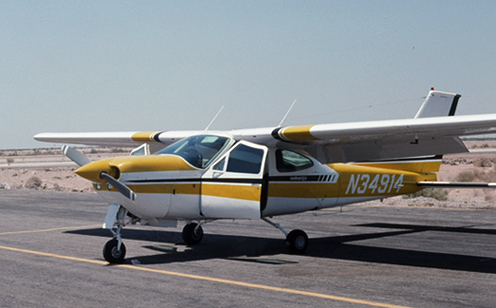
All low-wing birds
must be extinct.
-- Old Cessna
Pilot
Private flying is a scarce privilege,
almost uniquely American. Nobody, though -- not even
an aviation enthusiast -- would say that private
flying is the most pleasurable activity in the
world. That terminology, by convention, is reserved
for something else. For many persons, a trip in the
sky aboard a light airplane ranks as a close second.
Not everybody agrees.
GMT Greenwich Mean Time, also
called 'Zulu.' Noon in November in New York is
'one-seven-zero-zero Zulu.' Being gradually
displaced by CUT
(Coordinated Universal Time).
GPS Global
Positioning System, precise, feature-rich navigation
system using signals received from a fleet of
low-orbiting satellites. Also see FMS.
ground effect
Increased pressure underneath the wings produced by
flying close to the ground. An overloaded airplane
taking off on a hot humid day may not be able to fly
without it. Upon reaching the airport boundary, such
a hapless airplane can experience another kind of
ground effect.
groundspeed
The speed (in knots usually) at which the airplane
moves ('makes good') over the ground. Distinguished
from airspeed. With a
'tailwind,' the groundspeed is faster than the
airspeed. With a 'headwind,' the groundspeed is,
alas, slower.
GUMP Abbreviated
pre-landing checklist: Gas (fuel selector on the
fullest tank), Undercarriage (that's "landing gear,
Old Chap"), Mixture (full rich), Propeller (highest
RPM).
| On an instrument
approach, the pilot has plenty of
things to do. The author concocted
"Check freak killers and Miss High Time's
Speed" for pre-landing checklist: set up
approach frequency (freak); study approach
chart for obstacles and terrain hazards
(killers), recite the missed approach
procedure (miss), review decision altitude
(high), set timer for missed approach limit
(time), and slow to approach speed (speed).
After all that, GUMP. |
glide Un-powered
descent (see throttle).
For a typical light plane, gliding at
65 knots, the descent rate is 600 feet per minute
(about 6 knots in the downward
direction).
gyro A
spinning mass inside certain instruments vital to the
safe conduct of flight under IMC.
There are three such instruments.
The 'artificial horizon' or 'attitude
indicator' is the primary gyro instrument. Because
of the idiosyncratic behavior of the magnetic
compass, the pilot relies instead on the 'direction
gyro' or 'heading indicator.'
Finally, there's the old 'needle-and-ball' or the
new 'turn coordinator' that tells the pilot the rate
at which the plane is turning and whether the turn
is 'coordinated' (yaw in balance
with roll).
hangar An enclosure for
housing aircraft. From Medieval Latin angarium,
shed for shoeing horses.
 heading
The direction the plane is pointed with respect to
True North (true heading) or Magnetic North
(magnetic heading). Because of wind, heading
does not necessarily correspond to the intended course, the latter achieved by
a 'cross-track correction' (see crab). heading
The direction the plane is pointed with respect to
True North (true heading) or Magnetic North
(magnetic heading). Because of wind, heading
does not necessarily correspond to the intended course, the latter achieved by
a 'cross-track correction' (see crab).
headway Separation,
measured either in nautical miles or time between
successive aircraft flying in the same direction on
a common airway at the same altitude.
Headway has made its way
from nautical terminology to aviation via
railroading (see approach gate). Leeway is another
transportation concept that ought to be
brought into aviation (see "Headway vs Leeway").
HIRL High-Intensity
Runway Lights, a row of lights located at the approach
to a runway that flash in rapid succession to provide
a visual reference at the conclusion of an ILS approach.
For the story of its
invention, see "Flash
in
the Sky."
holding pattern
In planes -- unlike trains and automobiles -- one
cannot just tell the vehicle to stop when there is
congestion ahead. The holding pattern was invented to
cover that case. It is part of the concept of a
'clearance limit' under IFR.
| The holding pattern is
shaped like a race track in the sky.
Actually a stack of them, each separated by
a thousand feet. One plane at a time can
occupy any particular level. Think of a half
dozen Indianapolis 500's piled up over a
navigational fix.
The holding pattern
comprises four parts, each requiring one
minute. (1) Upon reaching the
assigned fix, you make a 180-degree turn
at three degrees per second; (2) fly
outbound for one minute on an assigned
heading; (3) make a 180-degree turn back
inbound at three degrees per second; (4) "home in" on the fix,
like cruising along the straight-away at
Indianapolis.
|
hood A large plastic
hat-like contraption with a drooping brim that
blocks the pilot's view out the window, thereby
simulating instrument meteorological conditions (IMC)..
The IFR instructor
acts as a safety pilot to watch for other airplanes.
The weather might be perfectly clear, but the
student 'under the hood' must conduct the whole
flight by reference only to instruments. {Under
the
Hood}
homing Steering toward
a waypoint or destination, often guided by ADF tuned to a navigational signal
such as a beacon.
As the aircraft approaches
the homing source, navigation errors decrease,
reaching zero overhead the beacon. For any
outbound course, of course, navigation errors
increase with distance, much the same as for dead reckoning.
The phrase honing
in
on may be an imperfect appropriation for
popular usage.
IFR Instrument
Flight Rules, a rigorous set of principles and
procedures that assure safe operation into and out of
airports and enroute separation from other aircraft,
in weather conditions that preclude operating under VFR, Visual Flight Rules.
One requirement is called a 'clearance,' which
constitutes a contract between the pilot and flight
controllers that sets forth the de-fault procedures
to be followed if a break-down occurs in
air-to-ground communications.
The informal expressions "flying on
instruments" or "flying IFR" mean controlling the
plane by reference only to gauges on the panel,
especially those that incorporate gyros,
a mode of flight necessitated by "IFR conditions,"
which is a phrase now generally replaced by "IMC" for "Instrument
Meteorogical Conditions."
ILS Instrument
Landing System, electronic equipment that guides an
airplane precisely onto the runway.
Two of its subsystems, 'localizer' and
'glide slope,' are radio transmitters on the ground
which define respectively the straight-in course
over the ground and the vertically slanting path to
the touch-down point. A pair of needles on the panel
provide the requisite guidance. On my approaches, it
looks like a sword fight.
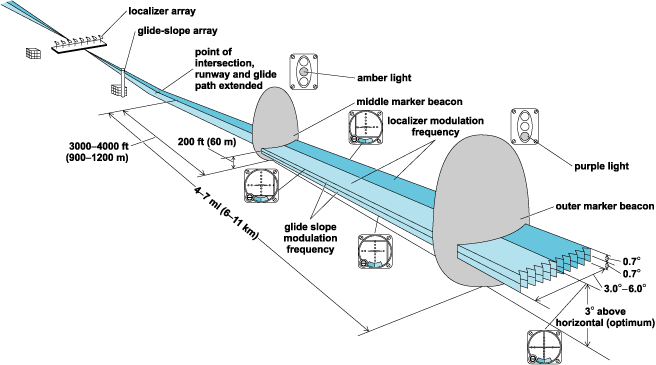
ILS Approach,
a sequence of essential tasks performed by the pilot
in transitioning from cruising flight through to
touchdown using the ILS, typically
including at least 18 steps.
- Fly level at initial
approach speed on an assigned heading.
- Intercept the
localizer (vertical needle).
- Turn to
localizer/runway heading.
- Become "established"
on the localizer, correcting for
crosswind.
- Recognize "outer
marker" beacon, report to control tower.
- Deploy landing gear
and extend partial flaps.
- Intercept the
glide-slope (horizontal needle).
- Reduce power to final
approach speed
- Become "established"
on the appropriate descent-angle.
- Recognize "middle
marker" beacon.
- Extend full flaps and
maintain glide-path
- Descend to "minimum descent
altitude."
- Apply power and
maintain altitude if the runway is not
in sight.
- Recognize runway
approach lights,
- Report to control
tower "Landing assured."
- Reduce power, kick out
crab-angle, flare-out, and touchdown.
- Retract flaps, apply
brakes.
- Speed permitting, turn
onto assigned taxiway.
|
IMC Instrument
Meteorlogical Conditions (see IFR).
iniquity Flying under
the influence, with passengers. Compare to stupidity.
intersection A fix or
waypoint defined by the crossing of radials from two
omni stations.
A number of years ago, the FAA changed
all intersection names to five-letter words,
ostensibly pronounceable. Computers again, folks.
Back when I started flying, there were no such
constraints. Intersections were named for what
underlay them, usually a city. Thus, Anaheim became
AHEIM; Tustin, TUSTI; El Monte, ELMOO. Out in the
ocean, we had Albacore, which became ALBAS, and
Mermaid, which is now, alas, MERMA.
| My flying instructor John,
who is featured in several chapters (Two-Four Fox, License to Learn)
for his nonchalance about regulations,
did not himself have an instrument
rating. That did not stop him from
filing a “pop-up” IFR
request during one of my early
lessons. It was a night flight in
“actual” IMC. John and
I got vectored all over the Los Angeles
Basin.
“Two-Four Fox, report
Alhambra intersection," said the voice
on the speaker.
I was struggling with
altitudes and headings, but I watched
while John flicked his flashlight all
around the LA Sectional in his
lap.
“Here it is,” he said,
“La Habra is 15 miles further.”
“Um, John, you mean
‘farther’.”
“That’s what I
said. Hold whatcha got for another
15 miles.”
“For distances, the word
is ‘farther’
not ‘further’,”
said
I, pulling his chain. La Habra is
15 miles farther than
Alhambra.”
John dismissed my
pedantry with a shrug.
“Besides, John, didn’t
that guy tell us to report at the
‘Alhambra’ intersection not ‘La Habra’?”
He shined his flashlight
on the chart and handed me the mike.
“Yeah, guess you better tell ‘im we’re
there.”
|
Being limited by computer protocols
to five letters might not always be much of a
hindrance after all (ALHAM vs LAHAB)
knot Nautical mile per hour (MPH): 100 knots
corresponds to 115 MPH.
leeway Nautical
terminology, which, alongside headway,
has meaning in making the distinction between, say,
the flexibility of General
Aviation and scheduled airline operations.
lift The upward
force of the air upon the wings.
In level flight, lift acts vertically
(opposing weight) and produces -- well, level
flight. When you bank the
plane, part of the lift acts horizontally to cause a
turn.
"line-up and
wait" A clearance given by the Local Controller that
authorizes a plane ready for departure to move onto
the runway in preparation for "cleared for takeoff"
(changed in 2010 from "taxi into position and hold").
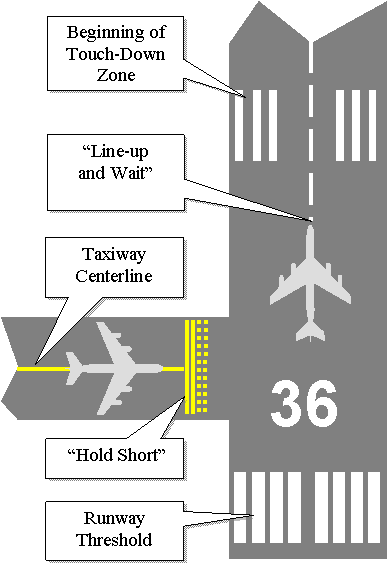
Local Controller The
person in the Control Tower who authorizes takeoffs
and landings.
longeron A
fore-and-aft framing member in an airplane.
Longeron is one of the few pure
aviation terms and was derived from the French word
(to pass along). Other French contributions: aileron, empennage,
and fuselage.
LORAN Long Range
Navigation system applies an onboard receiver to
process signals from a set of ground-based,
low-frequency transmitters, generally replaced now by
GPS.
LSA Light Sport
Aircraft [Work in Process]
mayday
internationally recognized distress signal via
radiotelephone (from the French m'aider),
shortening of venez m'aider "come help me!"
MFD Multifunction
Display, a member of the expanding family of
flat-screen, glass cockpit instruments.
mile
Two sizes: statute mile (sm
5,280 feet) and nautical mile (nm 6,080 feet),
resulting in two different units for airspeed and winds aloft.
You can get from one to the
other by multiplying or dividing by 1.1515, but
there's seldom enough time for that. The nautical
mile corresponds to one minute of latitude.
Since the 1960s only nautical miles
are used in aviation, which, like GMT,
was a long-overdue standardization for safety (see
Which Way,
Amelia?).
 MSL (Above) Mean Sea
Level, the measurement of altitude provided by the
airplane's altimeter.
Compare to AGL, Above Ground
Level. Also see flight
level. MSL (Above) Mean Sea
Level, the measurement of altitude provided by the
airplane's altimeter.
Compare to AGL, Above Ground
Level. Also see flight
level.
Illustrated on the right is
the altimeter indication for a plane at 6,264 feet
MSL.
navigation Determining
one's location and guiding the control of heading to
achieve a desired course.
Appropriated by aviation
from nautical parlance, the term is gradually being
replaced by avigation.
Navigator's
Definitions: 'Latitude' is where we are lost,
and 'Longitude' is how long we have been lost
there.
-- USAF Navi-guesser - Woo Hoo
NDB Non-directional beacon.
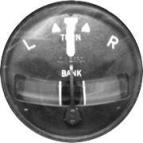 needle-and-ball
Obsolete predecessor to the turn-coordinator. needle-and-ball
Obsolete predecessor to the turn-coordinator.
NOTAM NOtice To AirMen.
Never mind the
gender-specificity, NOTAMs are official bulletins
distributed from the FAA by
subscription and via up-to-the-minute communications
over the radio from Flight
Service, obligatory information generally for
the safety of flight.
north Direction toward
the North Pole (true north) or toward a site located
in Eastern Canada (magnetic north), a reference used
to determine an aircraft's heading as measured by a compass.
numbers, phonetic
Officially, there are only twelve ('one-two')
numbers used in radio communications: Zero, One,
Two, Three (pronounced tree), Four (fow-er), Five
(fife), Six, Seven, Eight, Niner, Hundred, Thousand
(tou-send).
| An altitude of 12,500 feet
is said "One-two tousand, fife hundred." You
do hear pilots taking shortcuts ("twelve
point five") but never controllers. By the
way 'point' is supposed to be said
"day-see-mal."
The numbers ten, eleven,
and twelve appear only preceding o'clock
to designate the relative bearing of traffic
or landmarks. 'Twelve o'clock' means
straight ahead, 'eleven o'clock' means 30
degrees to the left of straight ahead,
'one o'clock' means 30 degrees to the
right, and so forth. Pity pilots who have
grown up with digital watches.
In the expression, "inbound
with your numbers," the term is used to
summarize the current operating conditions
and procedures at an airport to save
repeated instructions from the controllers
(see ATIS).
"Landing on the numbers"
means touching down on the painted
numerals -- hey, at the beginning
of the runway.
|
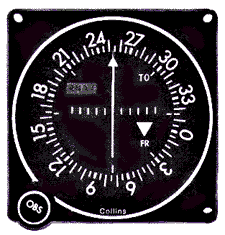 omni Short
for 'omnirange', the most common radio navigation
device in current use (also called VOR).
The term is used here for both the ground facilities
and the flight instrument. Unlike ADF,
reception of a VOR signal is limited to 'line of
sight' from the station to the aircraft. omni Short
for 'omnirange', the most common radio navigation
device in current use (also called VOR).
The term is used here for both the ground facilities
and the flight instrument. Unlike ADF,
reception of a VOR signal is limited to 'line of
sight' from the station to the aircraft.
There are hundreds of omni-range
stations in the United States and elsewhere. Each
defines a set of 360 invisible 'radials,' each
resembling the spokes of a wheel and corresponding
to the magnetic bearing of
the plane's position (not the airplane's heading). Certain radials are
shown on charts connected together forming the
'Victor' airway system.
The pilot first tunes his or her
omni receiver to the frequency of a nearby
station. Then, by centering a needle, the magnetic
course to or from the
station can be determined.
over Spoken at the end
of a radio transmission -- only when required to
inform the listener that a reply is expected.
Movie-makers take note: the term does not routinely
conclude every transmission.
pattern,
("landing pattern") A rectangular
flight path associated with each runway, one side of
which is the runway. It forms the conventional
framework for controlling the orderly flow of
aircraft to and from an airport.
There are five legs: upwind (straight
ahead immediately after take-off), crosswind (a ninety
degree turn at the departure end of the runway
either left or right depending on the published
pattern for that runway), downwind
(parallel and to the side of the runway), base (perpendicular
to the runway at the approach end), and final (lined up with
the runway, descending for touch-down).
Generally, you depart on a 45
degree angle from the upwind leg and enter the
pattern on a 45 degree angle to the downwind leg
("on the forty-five"). At controlled airports, you
may request such alternative procedures as a
"straight-out" departure or a "straight-in"
approach. And sometimes you will get cleared for a
mouthful: "mid-field crossing downwind entry."
Listen up.
| "Cutlass Three Seven
Romeo, Orange County Tower, continue on
the forty-five, for initial approach to
Runway One-Niner Right, remain west of the
airport, turn right abeam of the tower,
make mid-field crossing to a downwind
entry for Runway One-Niner Left and report
turning base."
"Yeah, I can do all
that. Thanks."
"I thought
so. You're welcome."
|
In Canada, by the way, MFCDE is the
standard procedure for pattern entry. It has
a significant advantage: altitude separation.
Since entry takes place directly above the runway,
any other aircraft in the pattern at that location
are rolling along the ground -- well below the
entering aircraft's pattern altitude (typically
800 to 1,000 feet AGL).
PFD Primary Flight
Display, a flat-screen glass
cockpit that combines FMS
and SVS.
P-factor A tendency
for a single-engine aircraft to yaw
to the left at high angle-of-attack,
most pronounced immediately following take-off and
during climb-out. In a twin, the P-factor
defines the 'critical engine'.
| As the wheels lift off the
ground at the beginning of your first flying
lesson, it will feel like your plane has hit
a patch of ice. Your instinct will be
to turn the "steering wheel" to the right;
however, that will only make matters worse
(see adverse yaw).
At that moment -- and often thereafter --
your instructor smirks and hollers over the
sound of the engine, "Get on that right rudder pedal!"
The propeller customarily
rotates clockwise as viewed from the rear.
Drag in "air
screw" might be expected to bank the
aircraft counterclockwise; however, the aelerons have much
greater mechanical advantage in the roll axis than the
propeller tips, making any banking effects
negligible. So why does the P-factor
show up in yaw?
Several explanations are
offered in aviation literature. One
suggests that the empennage
is rigged in the factory to match airflow
forces passing along the fuselage and
optimized for cruise speed. Those
forces are not exactly balanced in a
climbing maneuver. At full climb
power and with reductions in airspeed toward a stall, that effect
would decrease not increase. Another
explanation has it that the vertical stabilizer
gets pushed to the side by clockwise
spiraling propwash. However, that
would also decrease with speed, as more
time will be allowed for the spiraling
component of airflow to dissipate before
the rear of the plane can catch up to
it. Gyroscopic 'precession' of the
engine and propeller may contribute to the
P-factor, but that will manifest itself
only as a transient torque during pitch rotation not
as a steady-state condition while
climbing. Oh right, the gyroscopic
torque acts in the opposite direction to
the P-factor, yawing the aircraft to the
right not the left.
The best explanation is
based on the observation that in a climb
the upward inclination of the fuselage
tilts the plane-of- rotation of the
propeller away from its normal orientation
-- perpendicular to the flight path.
Accordingly, the downward-moving blade on
the righthand side of the aircraft is
advancing at an angle into the
relative wind and thus developing more thrust than the
upward-moving blade on the lefthand side,
which is retreating out of the
relative wind.
|
phugoid Often
spelled fugoid -- different
ancient roots for the same word, which means
"flight" in the sense of fleeing (think of
fugitive). The term is used in the phrase
"phugoid maneuver" to describe the oscillations,
most commonly in pitch, of an
aircraft that is allowed to fly on its own accord
(see diagram).
| A small atmospheric
disturbance, can cause a plane, which has
been trimmed for level
flight hands off, to pitch nose downward,
say. Airspeed increases, which
increases lift, raising the nose back up
again. With no corrections by the
pilot, inertia produces an overshoot into a
nose upward attitude. Airspeed now
slows, which decreases lift, lowering the
nose back down again. For a light
aircraft the period of oscillation might be
as long as 30 seconds. |
Pilot-in-Command (PIC) has ultimate
authority over all aspects of flight.
In theory, the PIC can
decline to comply with clearances given by
Air Traffic Control (ATC).
Any assignment by ATC -- altitude,
heading, route, runway, speed -- can be
rejected by the PIC.
There is one
exception.
Hold
Short (of an active runway) may be the
only mandate in aviation -- the only
utterance by ATC -- that must be obeyed by
the PIC.
ATC and the PIC collaborate
to assure safety. Thus, as a
practical matter, the PIC will negotiate
with ATC to resolve clearance
issues -- in flight. On the ground,
though, ATC's "hold short" holds primacy.
|
pilotage Term
preferred by pilots in place of dead
reckoning.
pitch Rotation of an
aircraft about a horizontal axis perpendicular to
the direction of flight (nose-up / nose-down),
controlled by the elevator.
Pitch is also used to
describe the 'bite' of the propeller.
The propeller is just a
big fan in front of the plane used to keep the
pilot cool. When it stops, you can actually
watch the pilot start sweating.
-- Old
Aviation Saying
pitot tube
External pressure sensing device, an essential part of
the pitot-static system that serves the airspeed indicator plus altimeter and vertical
speed indicator.
Named for its inventor,
Henri Pitot (1695–1771) a French hydraulic engineer,
the pitot tube has an external opening on an arm
projecting into the windstream that registers
"stagnation pressure" (also called "ram pressure")
and a port on the side of the aircraft that
registers "static pressure." The difference
between these two pressures indicates
airspeed. The altimeter is an aneroid
barometer. It uses the static pressure, which
is not static of course but varies with
altitude. A third instrument, the "vertical
speed indicator," measures the rate of change in
static pressure.
The pitot-static
system is elegant in its simplicity, with no
moving parts. There are occasions, however,
when faulty airspeed
indications can result in tragedy (Colgan
3497 and AF
447). The pilot must be prepared to
reject indications that don't jibe with elementary
realities of flight...
| Landing a rented Cessna
172 at Warner
Springs in a strong crosswind from
the left, I set up a radical side-slip. With
left-wing down at some 30 degrees bank
angle, I throttled back. Thus,
though we would touch down on the left
side first, the plane's wheels were all
lined up with the runway and I was
grinning. Then I glanced down at the
airspeed indicator.
It was showing the plane to be flying at
under 20 knots! Note the exclamatory
punctuation. Meanwhile, the needle
on the vertical speed
indicator was pointing down at more
than 1,500 feet per minute!
Oh right, and the altimeter
was reporting that the plane had already
descended to an altitude below the
runway elevation!
After the landing I
reminded myself that, to save
manufacturing cost for the 172, the
Cessna people install only one
pitot-static port (a small hole) in the
fuselage -- on
the lefthand side. In a side-slip to the left, the
static port is picking up increased air
pressure, reducing its difference from
the ram-pressure and thus reducing the
indication of airspeed.
Also, the increased static pressure
tricks the instruments into [a] an
erroneously low altitude and [b] an
exceptionally high rate-of-descent.
More advanced designs (Two-Four Fox, for
example) have static ports on both sides
of the fuselage, which balance out the
effects of uncoordinated
maneuvers.
|
position (see fix).
position report Message
spoken by the pilot over the radio during
flight. Under IFR ,
position reports are mandatory, for they clear the
block of protected sky behind your flight for
another flight. Under VFR,
position reports are optional procedures for safety
-- to reduce the search area (ugh) following a
mishap in the sky (see anecdote in Taciturn).
The minimal format has a
venerable mnemonic PTAND for Position
Time Altitude ETA Next
(fix) & Destination. On July 2,
1937, Amelia Earhart might have given a position
report as follows:
| USS Ontario, Electra
NR16020, VFR from Lae, New Guinea, landing
Howland Island. Position abeam
Nukumanu Island, 0618 GCT eight thousand;
estimating overhead your location at 0955
GCT; estimating Howland 2022 GCT.
Sky clear above cumulus clouds; wind 090
degrees at 23 knots; making good 131
knots; standing by 6120 kilocycles. |
pushing the envelope The
expression began in aviation. With the presence
of VLJs in the aviation fleet,
private pilots may approach transonic regimes and will
encounter forbidden corners of the flight envelope.
| Every aircraft has
permissible airspeed ranges and altitudes,
redlines and ceilings -- the limits
that characterize performance in level
flight or while maneuvering. Plotted
on a graph, these parameters form a set of
intesecting lines and curves enclosing an
area called the flight
envelope, a graphical representation
for constraints in the sky.
In commissioning each new
aircraft, some test pilot must take a
prototype aloft and execute exploratory
maneuvers to ascertain the extremities of
the design -- to find the edges and
corners of the flight envelope. Test
pilots have colloquialized the most
hazardous flight test procedures in a
phrase tinctured with bravado -- pushing the envelope.
Metaphorical
appropriations, "pushing the envelope,"
from jet-age flight testing has achieved
popularity for characterizing risky
behavior in business and government,
referring to the act of introducing
new ideas in readily established
concepts.
An example would be a
marketing campaign which advertised its
product in a way never done before seen,
or a video game which interacted with the
player in a completely original fashion.
|
ramp See tarmac.
A pregnant pilot who is a parent of an
only child would describe her condition as "one in
the hangar, one on the ramp."
range Normally a
measure of distance but also used to indicate an azimuth or bearing,
as in omnirange.
Oldtime pilots will
remember, without fondness, low-frequency
radio
range stations, which were decommissioned back
in 1970.
real-time
Completion of essential tasks at a pace matched to
that at which vital action is required. Often
characterized by relentless data rates and unforgiving
consequences.
One of the most useless
things for a pilot is one second ago.
-- Old
Aviation Saying
regs Nickname for FARs,
Federal Aviation Regulations, which govern all aspects
of flight in the U.S. (see FAA).
roger Spoken on the
radio, it means "I understand and will comply."
'Affirmative' -- not roger -- means 'yes'.
Etymology: from Roger, circa 1941 communications code word for the letter r
(now replaced by Romeo) -- used especially in radio
and signaling to indicate that a message has been
received and understood.
The term is seldom used except to
offer commiserations for flight delays or
turbulence.
roll Same as bank; both refer to the tilting of
an aircraft about an axis along the direction of
flight (left-wing-up/right-wing-up, see animation).
"Rolling" is also an atavistic
expression used by old pilots like me (pronounced
"Rollin'") to acknowledge "Cleared for take-off,"
referring with joy to the action of the wheels along
the runway.
RON Remain Over Night -- Best
advice, under certain
conditions (example).
rotation The pitch-up maneuver performed on the
runway during take-off, which increases the
angle-of-attack causing the wings to provide lift. The
time I say "Whoopee."
RPM Revolutions per
Minute, the speed at which an airplane engine swings
those paddles around, measured by the tachometer.
rudderThe movable
surface on the trailing edge of the vertical fin.
Operated by the action of the pilot's feet upon the
rudder pedals, the rudder controls yaw.
The fixed part is called the 'vertical stabilizer.'
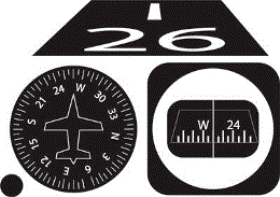 runway
Numbered at each end according to the magnetic
course of an airplane taking off or landing on it. runway
Numbered at each end according to the magnetic
course of an airplane taking off or landing on it.
The last digit of the course, of
course, is rounded. Thus, Runway One Niner has a
magnetic direction between 186 and 195 degrees.
Movie-makers take note: there are no runways with
numbers greater than 36.
sextant Handheld
instrument used in celestial
navigation.
In addition to a sextant,
the navigator needs a precise time piece (see chronometer), a nautical
almanac, and a plotting table. Then too,
the aircraft needs a transparent dome, and the pilot
needs a navigator. All have been made
obsolete by terrestrial radio systems (ADF, LORAN,
VOR) and by satellite-enabled
automation (GPS).

shag The verb 'to
shag' enjoys a thoroughly attested origin in baseball,
meaning to chase and catch fly balls in batting
practice and a venerated use in work-ups dating back
more than a half-century before it would be
appropriated as a leering euphemism for...never
mind. The term receives a personal meaning -- for an
aspiring aviator -- in Everlasting
Shagger.
skid An
uncoordinated maneuver which results from too much rudder (or not enough aileron, your choice) in a turn. Compare to slip.
An airplane might also skid
on the ground, much as any wheeled vehicle.
slip An uncoordinated
maneuver (possibly Freudian) which results from too
little rudder in a turn. Compare
to skid.
Intentional slips are useful for
making 'crosswind' landings
(see crab) or for rapid loss of
altitude ('forward slip').
solo An
early milestone on the way to becoming a licensed
pilot, it simply means flying an airplane alone -- no
instructor, no passengers. The ultimate in
self-reliance, I like to say.
For some pilots, a
thousand hours of flying experience really means
only one hour of flying experience over and over
again a thousand times.
-- Old
Aviation Saying
speed, maneuvering
Maximum airspeed at which abrupt, full movements of
the flight controls will not result in structural
damage to the airframe -- a vital limit when the
flight encounters severe turbulence.
| Maneuvering speed is not
marked on the airspeed indicator.
Because of its
dependence on gross weight, V A
must be placarded on the
instrument panel For
safety, heavier means faster. That
irony is explained by the fact that
increasing weight increases the aircraft's
stall speed.
One might want to read the previous
sentence again.
In stalling, the wings
are politely released from what I call
the "Grasp of Bernoulli." With a
lightly loaded airplane, one must slow
down, so that a sudden gust of
turbulence will intentionally cause
a stall. You may lose some
altitude, which you can spare, but not
your wings, of which you need both.
|
Flying is not
dangerous. Crashing is what is dangerous.
-- Old
Aviation Saying
spin An aerobatic
maneuver produced by deliberately aggravating an
unbalanced stall or a perilous
consequence of inadvertently aggravating an
unbalanced stall. Think of
only one wing producing lift. Uh-oh!
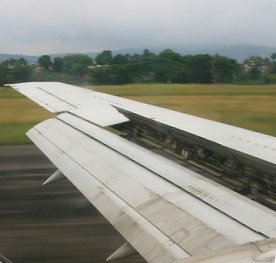 spoiler Narrow flat plates
typically fitted along the upper surface of each
wing. In normal flight, spoilers lie flat and have
no effect on the aerodynamic performance of the
wing. However, raised upward into the air flow over
the upper surface of the wings, spoilers generate
turbulence that reduces lift and increases drag. spoiler Narrow flat plates
typically fitted along the upper surface of each
wing. In normal flight, spoilers lie flat and have
no effect on the aerodynamic performance of the
wing. However, raised upward into the air flow over
the upper surface of the wings, spoilers generate
turbulence that reduces lift and increases drag.
In airliners, spoilers are
armed aloft for automatic deployment by "squat
switches" in the landing gear to facilitate maximum
braking in the runway roll-out. Expect to have
spoilers to operate in your personal VLJ.
In sailplanes, spoilers are used in
varying amounts to steepen the angle of descent as
desired by the pilot during landing approach, much
like the inverse of an engine throttle (see Two in One Day).
squawk Post-flight
complaint about malfunctioning aircraft equipment,
obviously not quite fatal. Also see transponder.
stack (see holding
pattern)
stall An aerodynamic
condition that develops when the angle-of-attack reaches a
high value (see stall
warning). The air flowing over the top of the
wing separates into turbulent eddies, and the wing
becomes exceptionally inefficient (see more about
stall here).
Push the controls
forward and the houses get bigger; pull back and
they get smaller -- that is, unless you keep
pulling all the way back, then the houses get
bigger again.
-- Old
Aviation Saying
One way a stall can occur is flying
too slow ("unable to obtain/maintain flying speed,"
the accident report will say). During training, the
student goes aloft to practice stalls -- rather
recovery from stalls. Two basic kinds: with power
(departure stalls) and without power
(approach-to-landing stalls). The remedy for
either is counter-intuitive: immediately push forward
on the controls.
For the airframe, ironically, a
stall is the least stressful maneuver
except for taxiing (see maneuvering
speed).
A 'full stall landing' is an
intentional maneuver resulting in the cessation of
flight at zero altitude (AGL)
and the lowest possible airspeed.
The aviation use of the word
'stall' has nothing to do with the engine.
Well, almost nothing (see FOD).
After more than a century of
aviation, 'stall' continues to be one of the
most poorly understood terms. Aviation
should have coined a distinctive term long
ago. The author of Chapters
in the Sky has proposed 'turbulation' to replace
'stall'.
Meanwhile, an aviation expert named
Gary LaPook made the following recommendation to
this author in 2011...
| We should find the person
who coined the word "stall" in English to
denote the loss of lift when the wings are
at too high an angle-of-attack,
dig him up, and [expletive deleted] on his
body. The French don't have this problem:
décrocage is their word for
'stall', no confusion with la panne de
moteur, engine failure. |
straight-and-level
Flight at a constant heading
and altitude.
The definition is easy; the
maneuver is not. In apparent contradiction to
Newton's Third Law of Motion, every action (of the
pilot) does not produce an equal and
opposite reaction (of the airplane). Flight
controls impose forces that are interconnected to
each other in counter-intuitive ways. You will
get some idea about that by regarding
straight-and-level as a coordinated
turn with an infinite radius.
stupidity Flying under
the influence, alone. Compare to iniquity.
The regs forbid
flying less than eight hours after drinking ("Eight
hours from bottle
to
throttle," the saying goes) or when
'hung-over', whatever that means. Objective
experiments have shown that, depending upon all the
familiar variables, alcohol can adversely affect the
pilot's performance of functions essential to flight
safety up to -- now get this -- 36 hours following
its consumption.
Never trade luck for skill.
--
Old Aviation Saying
SVS Synthetic Vision
System, provides three-dimensional images derived from
GPS databases, an optional feature
of some glass cockpits.
Old-time pilots will
doubtless complain that SVS effectively reduces your
aviation experiences to nothing more than flight
simulator sessions on a laptop.
tarmac Short for
'tarmacadam,' the paved area adjacent to a hangar or to the side of the runway (also called the ramp).
TCA
Terminal Control Area, positive controlled airspace
surrounding the busiest airports, in the shape of an
invisible inverted wedding cake -- intended to
exclude all aircraft not under the radar control.
| The concept is incomplete.
Airplanes are considered outside the TCA
even when they are inside the borders of a
TCA. All they have to do is fly above the
ceiling or below the floor of the
TCA.
Flying is a
three-dimensional activity. Radar
surveillance is not. Without altitude
information (see transponder)
for all aircraft, there is no way for
ATC to assure protection for any
aircraft, inside -- or outside -- a TCA.
|
thermals
See unstable air.
throttle Controls the
flow of fuel into the engine and therefore the amount
of power delivered by the engine.
| Within limits, the
throttle determines the vertical movement
of the plane (see elevator).
For a given airspeed (the elevator held in
a fixed position), one will cause the
plane to ascend or descend by changing the
throttle setting. Closing the throttle
produces a glide -- at an airspeed determined
by the elevator. Confusing, huh? |
thrust The forward,
pulling (or pushing) force produced by the engine(s). It
is thrust that overcomes drag.
TLD Triple-Letter
Designator, "They talk in TLDs / 'space-speak' if you
please."
ADF, AGL, ATA, ATC, CAP, CUT, DME, E6B, ELT, ETA, FAA, FAR, FBO, FBW, FMS, FOD, GCA, GCT, GMT, GPS, IFR, ILS, IMC, LSA, MFD, MSL, NDB, PFD, SVS,TCA, TLD, VFR, VLJ, VOR
top-of-the-green
Colloquial expression which means pushing the plane to
its maximum performance.
Several instruments in an airplane
(airspeed indicator, engine instruments) have green
arcs which mark their safe operating ranges. Some also
have yellow arcs or a redline that signify dangerous
operating regimes or absolute limits.
traffic Aircraft sharing
the same region of sky, often at great distances from
one another.
| To non-flyers, the term
connotes motor vehicles in close
proximity, all at the same altitude, of
course, accompanied by frustrating
delays.
Except in formation
flying, air traffic is typically
separated by miles and thousands of
feet. There can be delays, but the
popular expression "crowded skies" is
nevertheless misleading.
Imagine vehicular traffic
without signals. Or visit Shanghai.
There, you will find a white-gloved
'traffic controller' on every corner.
Throughout
the U.S., traffic control has been
automated. Except
in
the sky.
|
 transponder An airborne
electronic device which automatically responds to
querying pulses in synchrony with ground radar.
All transponders transmit an assigned ("squawk") code,
which identifies the airplane to radar controllers. Only
'Mode C' (altitude encoding) transponders provide a
measurement of the aircraft's altitude MSL.
Both are displayed on the radar screen in a box near the
plane's blip, also called 'primary echo.' transponder An airborne
electronic device which automatically responds to
querying pulses in synchrony with ground radar.
All transponders transmit an assigned ("squawk") code,
which identifies the airplane to radar controllers. Only
'Mode C' (altitude encoding) transponders provide a
measurement of the aircraft's altitude MSL.
Both are displayed on the radar screen in a box near the
plane's blip, also called 'primary echo.'
| To assure
interoperability, two frequencies are used
worldwide: 1,030 MHz for interrogation and
1,090 MHz for reply. The flight crew
sets the assigned squawk code into the
instrument using four thumbwheel switches
displaying octal digits, (limited to
cyphers 0, 1, 2...7), capable of
supporting no more than 4,096 codes.
Nota bene: code "0000" is not
used. Moreover, for declaring
emergencies aloft, the pilot will use any
of 64 codes starting with "77"; likewise
"76" signals a radio failure to radar
operators on the ground, "75" declares a
skyjacking in progress, and "12" means the
aircraft is operating under VFR. Thus, a net
of only 3,839 discrete codes are available
for routine use under IFR..
For background on the
altitude-reporting transponder and its
impact on ATC, see
the Internet Version of Squawk
1200:
A history of the next midair
collision.
|
trim An auxiliary
control that permits the pilot to balance out steady
forces on the corresponding main control.
All aircraft have elevator
trim. Some also have rudder
trim. A few have aileron trim.
A perfectly trimmed airplane in smooth air can be
flown 'hands-off.'
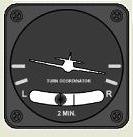 turn coordinator Modern replacement for
the needle and ball. turn coordinator Modern replacement for
the needle and ball.
The
instrument on the right is indicating a right turn
in progress -- a skidding right turn, actually, with
too much rudder.
turbulation Preferred
term for stall. An
original coinage published first here.
An
aircraft flying with an angle-of-attack
greater than some critical value (15 degrees,
typically) will be said to 'turbulate', as the air
over the top of its wing breaks away into turbulent
eddies, resulting in pronounced increase in drag. During
turbulation, the wings are politely released from
what I call the "Grasp of Bernoulli."
turn, coordinated Preferred manuever for changing heading. Exactly how to do
it is not so obvious, as you will learn in your first
flying lesson.
| Say you want to make a right
turn in level flight. You use what looks
like a steering wheel in front of you to apply
right aileron, and the
plane begins banking to
the right. At that moment, the left wing
is developing more lift
than the right wing and therefore more drag. The unbalance
causes your plane to yaw
to the left -- opposite to your
intended maneuver. That would be adverse yaw; however, you
prevent it by simultaneously applying right rudder. By the way,
the plane has not yet started to turn.
For a few seconds, you continue to fly
straight ahead with your wings going steadily
more crooked in the sky. Eventually, you will
have the 'angle-of-bank' that you intend to
use for your turn. You neutralize the
ailerons to stop the roll.
At last, the plane starts its turn.
With the heading changing
toward the right, the outside wing (the one
on the left) is now moving through the air
faster than the inside wing and developing
more lift. The result is that the
plane will continue rolling to the right,
increasing your angle-of-bank
("over-banking," it's called).
Naturally, you prevent that by applying
opposite (left) aileron. In resisting that
tendency for the plane to continue rolling
toward the inside of the turn, you have
intentionally increased the lift on the
inside wing and unintentionally
increased its drag, yawing the plane to the
right. That, too, would be regarded as
adverse yaw, except it is acting in the same
direction as the turn. Still, to avoid
over-banking you must apply left
rudder. The plane keeps turning
steadily toward the right at a fixed
angle-of-bank as you wanted.
Meanwhile, with the wings at
an angle to the horizon, some of their lift
is being subtracted from holding your plane
aloft and used instead to produce the
turn. If you don't do something about
that, your airplane will begin to pitch downward, losing altitude. You
prevent that by pulling back on the control
wheel which operates the elevator to increase
lift on both wings in unison. By the
way, that increases drag in both wings,
slightly slowing the airspeed. The plane
stays at the same altitude nice as you
please; however, part of that extra lift is
directed toward the right, simultaneously
increasing your rate-of-turn and the
tendency for the airplane to over-bank. To
prevent that, you crank in more left
aileron, which you must balance with more
left rudder. And so it goes.
There you are, all crossed up
in the cockpit: banked right, applying left
aileron and rudder, watching your heading
change to the right while pulling back on
the elevator to hold altitude. Quite
counter-intuitive and hardly 'coordinated'
when you think about it -- which you soon
learn not to do. Nothing like
driving a car, is it. Oh right, and to
stop the right turn, you must go
back to the top of this exercise and reverse
each action as if you want to make a left
turn. Almost.
Reminder: The purpose of a
turn is to take up a new direction of
flight, often on an assigned heading. That
imposes a timing requirement for
stopping the turn -- a requirement you don't
have when you're starting a
turn. Your car-driving intuition will
suggest that you should start gradually
rolling out level before reaching
that new heading so as not to turn too
much. But watch out.
All during your right turn,
you are holding left aeleron and
rudder. To stop the turn, you must
increase left aileron so that the inside
(right) wing develops more lift. Its
increased drag toward the right will
resist your effort in stopping the turn, so
you must apply more left rudder at the same
time. But how much more? Too
much left rudder will cause you to stop the
turn short of the desired heading; too
little and you can expect to overshoot
it. That's what you think,
anyway. In reality, the tendency will
be to use too much left rudder -- rather to
be tardy in reducing it. Here's why:
In your perceptions, angle-of-bank is far
more obvious than
rate-of-turn. While reducing
angle-of-bank, you will unsuspectingly stop
the turn almost immediately.
The effect is similar to the way overcoming
adverse yaw delays the start of a
turn. Although you won't find this
advice in any flight manual, you will
discover that the most practical stratagem
is to continue the turn until the plane just
about arrives at the heading you want, then
rack the plane level with plenty of aileron
and rudder while holding that heading nearly
constant.
With the turn abruptly
stopped, the plane still takes a few seconds
to finish rolling. As the wings become
level, their combined lift will no longer
act in the direction of the turn but instead
become fully devoted to holding the plane
aloft. While that is taking place, you
must remind yourself to stop pulling back on
the elevator, otherwise that extra lift you
needed in the turn will cause the plane to
nose up into a climb. Whoa! Simply
relaxing the elevator control will not be
enough, however. To regain the
airspeed lost during the turn, you will need
to push the control wheel forward
for awhile.
|
Unicom Communications
channels allocated for air-to-air coordination and
air-to-ground service requests, including fuel
service, ground transportation, and phone calls.
unstable air
A condition of the atmosphere in which small vertical
perturbations of the air produce runaway drafts.
"I would rather be down
here wishing I were up there than being up there
wishing I were down here.
-- Old
Aviation Saying
Two separate
properties of the air collaborate to
produce unstable air.
First, thermodynamics mandates a
change in temperature whenever a parcel of
air is moved vertically. Air blowing up the
side of a mountain, say, experiences a
decrease in pressure and consequently cools
to a lower temperature ('lapse rate,'
meteorologists call it).
Second, the measured
temperature of non-moving air generally
decreases with altitude ('temperature
gradient'). It simply gets colder outside
when you go higher up.
Consider what might happen
when a parcel of air gets lifted slightly.
Its temperature goes down. The surrounding
air at the higher elevation is also cooler
-- but probably not cooler by exactly the
same amount, since there are two phenomena
involved.
- Suppose that the
lifted parcel cools off to a temperature
lower than the surrounding air. The
parcel will be slightly more dense and
tend to sink back toward the elevation
from which it was lifted. That's stable
air.
- Suppose, on the other
hand, that the lifted parcel remains
slightly warmer than the surrounding air
higher up. Well, the lifted parcel would
be less dense and, instead of going back
down, it will be lifted still higher.
The cause of the initial lifting (an
up-slope breeze, perhaps) has been
reinforced by the thermodynamics of the
situation, and up goes our parcel of air
like a bubble.
On a clear, summer afternoon.
the sun shines through the atmosphere and
warms the surface. The air aloft is affected
hardly at all. It stays cool. The air
adjacent to the ground, though, is warmed.
The greater temperature difference -- you
should excuse the expression -- gives rise
to unstable air and the ascending currents
of air called 'thermals.'
Best to avoid such
convective frenzies. Fly in the morning.
|
upwind leg See pattern.
VASI Visual Approach Slope
Indicators. Two sets of stationary
lights adjacent to the beginning of the runway.
With lenses and masks, the lights form beams, such
that viewing them from above a specific angle (the
glide slope for that runway) shows white lights and
below that angle red lights. If the pilot can see red
on the set farther down the runway and white
on the closer set then he or she is on the glide
slope. White-over-white means the plane is approaching
too high and red-over-red too low.
Red-over-white, you're all
right. White-over-white, you're high as a kite.
Red-over-red, you're gonna be dead.
-- Old
Aviation Saying
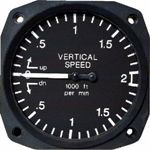 Vertical Speed
Indicator (VSI )
measures rate of climb or descent calibrated in feet
per minute. The instrument on the right is
indicating level flight -- level, not necessarily
straight. For that you might refer to your Turn Coordinator. Vertical Speed
Indicator (VSI )
measures rate of climb or descent calibrated in feet
per minute. The instrument on the right is
indicating level flight -- level, not necessarily
straight. For that you might refer to your Turn Coordinator.
vertigo Disoriented
condition, not knowing which way is up. Originally it
meant dizzy. In aviation, vertigo can be induced in
some people by turns without a visible horizon, in
others by movement of the head during acceleration
maneuvers.
| During instrument
flight training, the student spends many
hours flying around 'under
the hood.' The instructor periodically
takes over the controls and asks the student
to cover his or her eyes. Then the
instructor puts the plane through a sequence
of maneuvers -- some gradual, some not so
gradual -- designed to obliterate or confuse
sensory inputs. After establishing the plane
in an unusual attitude,
the instructor traditionally calls out,
"Your airplane!" Hah, then the fun begins.
The student sits up,
blinks, and analyzes the instruments, some
of which might have been concealed by
jar-lids. Everything goes askew. The plane
is either twirling toward earth or
clamoring for height. The task is to
re-establish straight and level flight as
quickly as possible.
That may not be the end
of the exercise, however. Sometimes, after
curing an unusual attitude on behalf of
the aeroplane,
the pilot becomes afflicted with a malady
of his or her own, vertigo. The student feels
like the plane is not level, even though
it is, and must consciously struggle not
to tilt the controls in obedience to
counterfeit stimuli.
|
VFR Visual
Flight Rules, a set of principles and procedures that
permit flight without reference to instruments. VFR is
dominated by the imperative "see and avoid" (formerly
"see and be seen").
Stay out of clouds.
The silver lining everyone keeps talking about
might be another airplane. Reliable sources
also report that mountains have been known to hide
out in clouds.
-- Old
Aviation Saying
Generally, to operate VFR, in-flight
visibility is required to be greater than three miles.
For landing and taking off, cloud 'ceilings' have to
be higher than 1,000 feet AGL.
In the past, 'VFR' was informally used
to denote the conditions that permit operating under
VFR (replaced by VMC).
VLJ
Very Light Jet [Work in Process]
VMC Visual
Meteorological Conditions (see VFR).
VOR VHF (Very High
Frequency) Omni Range, or omni.
VORTAC See DME.
 Voyager The author was a financial
sponsor (ahem) for its historic
flight in 1986 around
the world, non-stop and unrefueled. A
unique, center-line thrust, General
Aviation aircraft, the Voyager
flew most of the 26,358 miles on its rear (pusher)
engine, using its front (tractor) engine for the
flight's one and only take-off and for climbing
above mountains. Both powerplants were Continentals:
an O-240 developing 130 horsepower in front and a Liquid
cooled IOL-200
producing 110 horsepower in back. Voyager The author was a financial
sponsor (ahem) for its historic
flight in 1986 around
the world, non-stop and unrefueled. A
unique, center-line thrust, General
Aviation aircraft, the Voyager
flew most of the 26,358 miles on its rear (pusher)
engine, using its front (tractor) engine for the
flight's one and only take-off and for climbing
above mountains. Both powerplants were Continentals:
an O-240 developing 130 horsepower in front and a Liquid
cooled IOL-200
producing 110 horsepower in back.
V-Speeds a collection of nearly three-dozen
different indicated airspeeds
pertinent to the safe conduct of flight. Here
are their abbreviated names and meanings.
Caution is advised: an 'M' can mean variously either
maximum or minimum...
V A
~~~~~~ design maneuvering speed.
V B
~~~~~~ design speed for maximum gust
intensity.
V C
~~~~~~ design cruising speed.
V CC ~~~~~~~ recommended
cruise-climb speed (coined here)
V D ~~~~~~~
design diving speed.
V DF ~~~~~~
demonstrated flight diving speed.
V EF ~~~~~~~ the
speed at which critical engine is assumed to
fail during takeoff.
V F
~~~~~~~ design flap speed.
V FC ~~~~~~
maximum speed for stability characteristics.
V FE
~~~~~~ maximum flap extended speed.
V FTO ~~~~~
final takeoff speed.
V H ~~~~~~~
maximum speed in level flight with maximum
continuous power.
V LE ~~~~~~
maximum landing gear extended speed.
V LO ~~~~~~
maximum landing gear operating speed.
V LOF ~~~~~
lift-off speed.
V MFC
~~~~ maximum speed for stability
characteristics.
V MC
~~~~~ minimum control speed with the
critical engine inoperative.
V MO
~~~~~ maximum operating limit speed.
V MU
~~~~~ minimum unstick speed.
V NE
~~~~~ never-exceed speed.
V NO
~~~~~ maximum structural cruising
speed.
V R ~~~~~~~
rotation speed.
V REF ~~~~~
reference landing speed.
V S
~~~~~~ stalling speed
V S0 ~~~~~~
stalling speed in the landing
configuration.
V S1
~~~~~ stalling speed or in a specific
configuration.
V SR
~~~~~ reference stall speed.
V SRO ~~~~
reference stall speed in the landing
configuration.
V SR1
~~~~ reference stall speed in a
specific configuration.
V SW
~~~~ speed at which onset of natural
or artificial stall warning occurs.
V X
~~~~~ speed for best angle of climb.
V Y
~~~~~ speed for best rate of climb.
V 1
~~~~~~ maximum speed in the
takeoff at which the pilot must take the
first
action
(apply brakes, reduce thrust, deploy speed
brakes) to stop
the
airplane within the 'accelerate-stop
distance'.
V
1 ~~~~~ minimum
speed in the takeoff, following a failure of
the critical
engine
at VEF, at which the pilot can continue the
takeoff and achieve
required
height above the takeoff surface within the
takeoff distance.
V 2 ~~~~~~
takeoff safety speed. |
WAAS Wide
Area Augmentation System, a system of satellites and
ground stations that provide GPS
signal corrections, giving the pilot a position accuracy
of three meters 95 percent of the time.
warning, stall. An electric horn or buzzer
energized by a wind-activated switch mounted on the
leading edge of the wing, which signals an impending
stall as the angle-of-attack
reaches a critical angle (about 15 degrees for many
airplanes).
waypoint (see fix).
weight-'n'-balance,
pronounced as one word, although two decidedly
different flight parameters are involved.
| The load-carrying capacity of
an aircraft is limited ultimately by the lift of its wings at
take-off and the strength of its undercarriage
during landing. It is incumbent upon the pilot
to tally up the weight of passengers and
luggage, fuel and -- oh yes -- airframe to
assure that certified 'gross weight' not be
exceeded.
The controllability of the
aircraft is limited by the 'pitch-authority'
of its elevator,
which depends on how weight is distributed.
An aircraft is obviously
heaviest at the moment of take-off and gets
steadily lighter throughout the flight (the
only exception is when icing is encountered,
but -- hey, it's the pernicious effect of
ice on the airfoil not its weight that can
bring down a plane).
Not so obvious is the
location of an aircraft's center-of-gravity,
which can change during flight. 'Nose-heavy'
and any hope of 'up' gets to be out of the
question. 'Tail-heavy' and -- well, a stall may result, but
recovery won't be physically possible.
|
winds aloft Forecasted
as speed (in knots) and
direction (true, not magnetic)
for selected altitudes (MSL) based
most often on measurements by radiosonde
or empirically during flight by means of WCA Wind Correction
Angle.
windsock
yaw Rotation of the
airplane about a vertical axis perpendicular to the
direction of flight (nose-left/nose-right) controlled
by the rudder (animation).
Yaw is just one of the three axes about
which an airplane can be rotated (the other two: pitch and roll).
Incidentally, yaw is the only control axis you have
for an automobile or a boat. How dull.
yaw, adverse
Consequence of an unbalance in wing drag
when subjecting an airplane to a roll
maneuver for a coordinated turn.
zero-zero
Ceiling zero and visibility zero, the extreme opposite
of CAVU. Inside a
cloud, visibility is zero. At some non-zero elevation
AGL, clouds can form a real ceiling, so 'zero-zero' is
somewhat redundant, but the condition deserves to be
emphasized.
| Equipped with modern gyro instruments, private
aviators can indeed take off safely in a ground
fog. At this writing, airliners cannot.
After lining up with the
runway by reference to a couple of runway
lights, looking through the windshield is a
bad idea. Everything depends on the
instruments. The most essential information
on the take-off roll is the heading. Best to
tweak the direction gyro
slightly to one side so as not to confuse
any of its degree markings with the
reference line ('lubber,' in nautical
terms). It's an exciting experience, I
can tell you...
Bring the power up smoothly
while releasing the brakes. Apply slight
back pressure on the elevator.
Check engine instruments for full power.
Feel the acceleration. Adjust heading with
rudder. Check airspeed. Heading again.
Airspeed for rotation.
Refer to artificial horizon and lift nose
wheel. Feel lift-off. Hold right rudder
against the P-factor.
Vibration in the spinning wheels can
be a source of distraction: tap brakes.
Wings level. Check heading.
Now altitude. Trim
for best rate-of-climb. Reach for
microphone. "Airborne."
|
zoom To climb suddenly,
trading airspeed
for altitude.
A good time to say, "Whoopee."
Take-offs are
optional. Landings are mandatory.
-- Old
Aviation Saying
|

 airspeed
The speed at which the airplane moves through the air
expressed in knots
(kts nautical miles per hour).
airspeed
The speed at which the airplane moves through the air
expressed in knots
(kts nautical miles per hour).
 All
things that move through fluids experience drag.
Airplanes are distinguished by the fact that for them,
there are two kinds of drag. Common old ordinary drag
is called 'parasite' drag, which becomes greater with
increasing speed, the same as for barracuda and boats,
bikes and blimps, bullets and buses. Airplanes
also experience a pernicious form of drag, which
paradoxically increases at low airspeeds. It is called
'induced' drag -- induced by the act of flying.
All
things that move through fluids experience drag.
Airplanes are distinguished by the fact that for them,
there are two kinds of drag. Common old ordinary drag
is called 'parasite' drag, which becomes greater with
increasing speed, the same as for barracuda and boats,
bikes and blimps, bullets and buses. Airplanes
also experience a pernicious form of drag, which
paradoxically increases at low airspeeds. It is called
'induced' drag -- induced by the act of flying.
 drift meter Telescopic
instrument (obsolete) used in dead
reckoning, that enabled an aircraft navigator to
peer down through the aircraft's fuselage
and measure the lateral motion of objects on the
ground thereby enabling adjustments of the aircraft's
heading to correct for
crosswind.
drift meter Telescopic
instrument (obsolete) used in dead
reckoning, that enabled an aircraft navigator to
peer down through the aircraft's fuselage
and measure the lateral motion of objects on the
ground thereby enabling adjustments of the aircraft's
heading to correct for
crosswind.



 MSL (Above) Mean Sea
Level, the measurement of altitude provided by the
airplane's altimeter.
Compare to AGL, Above Ground
Level. Also see flight
level.
MSL (Above) Mean Sea
Level, the measurement of altitude provided by the
airplane's altimeter.
Compare to AGL, Above Ground
Level. Also see flight
level.
 transponder An airborne
electronic device which automatically responds to
querying pulses in synchrony with ground radar.
All transponders transmit an assigned ("squawk") code,
which identifies the airplane to radar controllers. Only
'Mode C' (altitude encoding) transponders provide a
measurement of the aircraft's altitude MSL.
Both are displayed on the radar screen in a box near the
plane's blip, also called 'primary echo.'
transponder An airborne
electronic device which automatically responds to
querying pulses in synchrony with ground radar.
All transponders transmit an assigned ("squawk") code,
which identifies the airplane to radar controllers. Only
'Mode C' (altitude encoding) transponders provide a
measurement of the aircraft's altitude MSL.
Both are displayed on the radar screen in a box near the
plane's blip, also called 'primary echo.'
 turn coordinator Modern replacement for
the needle and ball.
turn coordinator Modern replacement for
the needle and ball.





 ADF, Automatic Direction Finding is
an onboard receiving instrument, with a needle
that continuously indicates
ADF, Automatic Direction Finding is
an onboard receiving instrument, with a needle
that continuously indicates 




 runway
Numbered at each end according to the magnetic
course of an airplane taking off or landing on it.
runway
Numbered at each end according to the magnetic
course of an airplane taking off or landing on it.



